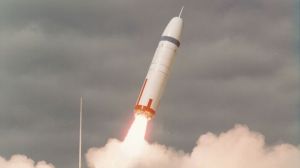‘US deploys “usable” nuclear weapon amid continuing war threats against Iran’, 1 February 2020, Bill Van Auken, wsws.org
“The Pentagon deployed a new, smaller nuclear warhead aboard the ballistic missile submarine USS Tennessee as it sailed into the Atlantic last month in the midst of the spiraling crisis with Iran. The weapon, known as the W76-2 warhead, has an explosive yield of roughly five kilotons, a third of the destructive power of the “Little Boy” bomb that claimed the lives of some 140,000 people in Hiroshima in 1945.
The Federation of American Scientists (FAS) revealed the deployment this week, citing unnamed civilian and military figures. It stated that two of the 20 Trident submarine-launched ballistic missiles onboard the USS Tennessee and other subs will be armed with the W76-2 warheads. Each missile can be loaded with as many as eight such warheads, capable of striking multiple targets.” [snip]
[The FAS link is here; it’s long, but definitely worth reading when you have the time.]
“The new weapon has been rolled out with remarkable speed. The Trump administration’s 2018 Nuclear Posture Review called for the development of “a low-yield SLBM [submarine-launched ballistic missile] warhead to ensure a prompt response option that is able to penetrate adversary defenses” and close “an exploitable ‘gap’ in US regional deterrence capabilities.”
The pretext for the warhead’s deployment was the unsubstantiated claim that Russia is developing similar weapons and has adopted a doctrine of “escalate to de-escalate” or “escalate to win” by utilizing low-yield nuclear weapons, with the expectation that Washington would not retaliate with strategic warheads for fear of initiating an all out thermonuclear war. The Pentagon’s argument has been that a low-yield and rapid reaction ballistic missile is needed to “restore deterrence.”
The report by the FAS strongly suggests, however, that this alleged Russian doctrine is a pretext and that “it is much more likely that the new low-yield weapon is intended to facilitate first-use of nuclear weapons against North Korea or Iran.”
It points out that both the US National Security Strategy and the Nuclear Posture Review (NPR) envision the use of nuclear weapons in response to “non-nuclear attacks, and large-scale conventional aggression,” and that the NPR explicitly stated that the W76-2 warhead was designed to “expand the range of credible US options for responding to nuclear or non-nuclear strategic attack.” Washington does not rule out a nuclear strike, including against non-nuclear armed countries like Iran.
The deployment of the USS Tennessee with its new “usable” nuclear warheads came at roughly the same time as President Donald Trump huddled with his top aides on December 29 at his Mar-a-Lago resort in Florida, ordering the criminal drone missile assassination of Gen. Qassem Suleimani, one of Iran’s top officials. The drone killing was carried out at Baghdad’s international airport five days later.
In a report Thursday, NBC News, citing unnamed senior US officials, established that at the same meeting in Florida, “Trump also authorized the bombing of Iranian ships, missile launchers and air defense systems… Technically, the military can now hit those targets without further presidential authorization, though in practice, it would consult with the White House before any such action.”
The report warned that “the two sides remain in a dangerous boxer’s clench, in which the smallest miscalculation, some officials believe, could lead to disaster.” [snip]
“After securing a $738 billion military budget for 2020 with the support of an overwhelming majority—Democratic and Republican alike—in the US Congress, the Trump administration is now preparing to push through a 20 percent increase in the budget for the National Nuclear Security Administration (NNSA), the agency overseeing the buildup of the US nuclear arsenal. This $20 billion budget proposal, made public this week, represents only a fraction of the more than $1 trillion the US is projected to spend on “modernizing” the arsenal over the next three decades—plans that were set into motion under the Democratic administration of Barack Obama, before Trump took office.” [snip]
“…the articles of impeachment center on allegations that he withheld lethal military aid to Ukraine and has been insufficiently aggressive in confronting Russia.
This charge is made, as Newsweek pointed out this week, after the Pentagon staged an unprecedented 93 separate military exercises between May and the end of September of last year, all of them simulating or preparing for war against Russia. This includes practice bombing runs less than 500 miles from the Russian border and the steady build-up of ground forces in the three Baltic states and Poland, together with escalating US air deployments described as “bomber assurance” and “theater security” programs.”
From the Bulletin of Atomic Scientists: ‘The low-yield nuclear warhead: A dangerous weapon based on bad strategic thinking’, Andrew Facini, January 28, 2020. thebulletin.org
“Low-yield, high risk. The Trump administration first announced its plans for a new low-yield nuclear warhead in its February 2018 Nuclear Posture Review, a public report meant to communicate and clarify various American nuclear weapons policies.”
“But proponents of the low-yield warhead overlook or dismiss a few key concerns that make the W76-2 an unrealistic military option.
First, the imagined target for such a weapon is yet unclear. For most military units and installations, conventional weapons would be a more viable option. For more “strategic” targets like cities or hardened bases, anything but a full-sized nuclear attack would risk failure. What value does a low-yield warhead have if its primary mission is poorly defined? Further, even if an ideal target did present itself, the value and urgency in striking would need to be such that crossing the nuclear barrier would be well worth the precedent it sets.
Second, launching low-yield missiles would create a so-called “discrimination problem.” Since US nuclear submarines will carry both the low-yield and the full-size options, it would be impossible for a potential adversary to determine which kind of warhead a ballistic missile would be carrying until it impacted, leaving no reasonable room to recognize the comparative nuance of a low-yield strike. With a very short window to decide where and how to retaliate, an enemy may just as well assume the worst, and choose a full-sized response.
Third, launching a ballistic missile from a submarine risks revealing that submarine’s location instantly, making it an extremely high value target for a rapid enemy response. Since American ballistic missile submarines are primarily tasked with a “survivable second strike” deterrence role, divulging the whereabouts of any of them at the beginning of a nuclear war would be foolish.” [snip]
[Warning: More Obomba Hypocrisy Alert re: ‘his JCPOA’ ahead:]
“Reporting by Newsweek in January 2020 revealed that in 2016 the United States held a wargame featuring the Air Force’s B61 nuclear bomb—another weapon with a low-yield option—in an imagined battlefield situation against Iran. Despite signing a landmark nonproliferation agreement with Iran the previous year, the Obama administration saw fit to train its command and control systems for a nuclear attack against a non-nuclear state. [Iran] Officers speaking on the record to Newsweek about the exercise even identified the W76-2 as an imagined first-strike option for such a scenario, suggesting that its deployment is “explicitly intended to make the threat of such an attack more credible.
“These and other techno-strategic concerns have been well covered since the 2018 Nuclear Posture Review, and a wide array of nuclear experts have voiced dissent for the W76-2 program. Nonetheless, by January 2019 the warhead was reportedly in production, and despite early vows to block the program, House Democrats passed a defense budget in December that allocated funds for its continuation [<post conference with the Senate version].”
 …………………………………………………………………………………………………………….
…………………………………………………………………………………………………………….
For further reading: Report by Stockholm International Peace Research Institute (SIPRI) says there are an estimated 13,865 nuclear weapons in the hands of nine states (June 2019 estimate) , including Israel’s ‘nuclear ambiguity’ estimated at between 80 and 90.
‘Emerging technologies and nuclear risks’, icanw.org, which opens:
“Emerging technologies could significantly increase the risk of nuclear weapons use. New developments in offensive cyber capabilities, artificial intelligence and autonomous technologies will significantly impact on military behaviour, and experts agree that they could add another layer of risk to an already unacceptable level of risk of nuclear weapons use.
Any use of nuclear weapons, either by intent, accident or miscalculation, will cause catastrophic humanitarian consequences, so it is critical that policymakers and the public understand the pre-existing dangers of nuclear weapons as well as added risks posed by emerging technologies. Adopting measures that only seek to reduce or mitigate the additional risk that emerging technologies pose to nuclear weapon use is not an adequate response to the nuclear status quo. Eliminating nuclear weapons is the only way to eliminate these risks altogether.”
#War Is a Racket: Defense Daily’s home page; click in just to read the headlines, including ‘Defense’ industry behemoths’ 4th Quarter ‘earnings’ are up, up, up!:
(cross-posted at caucus99percent.com)



